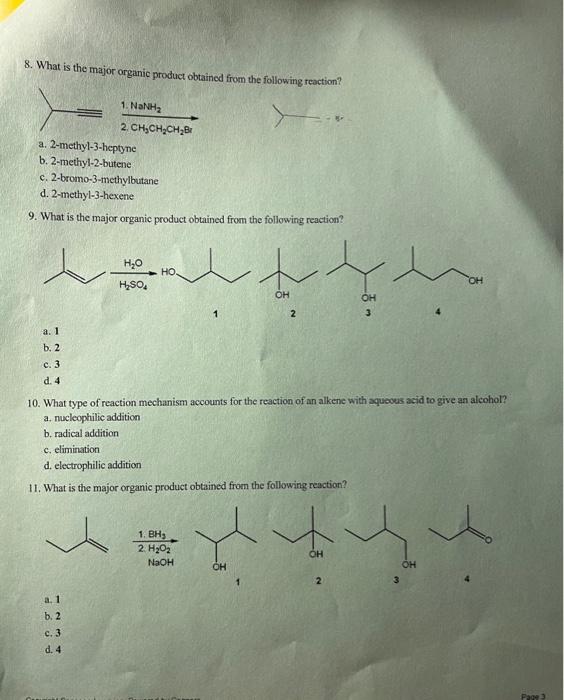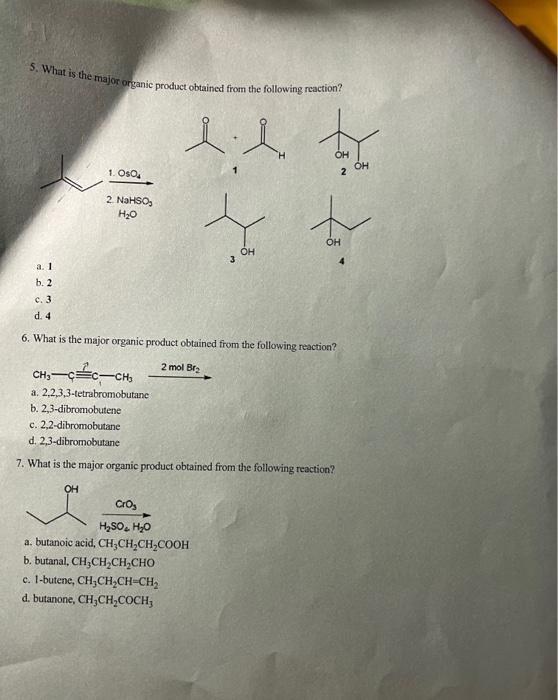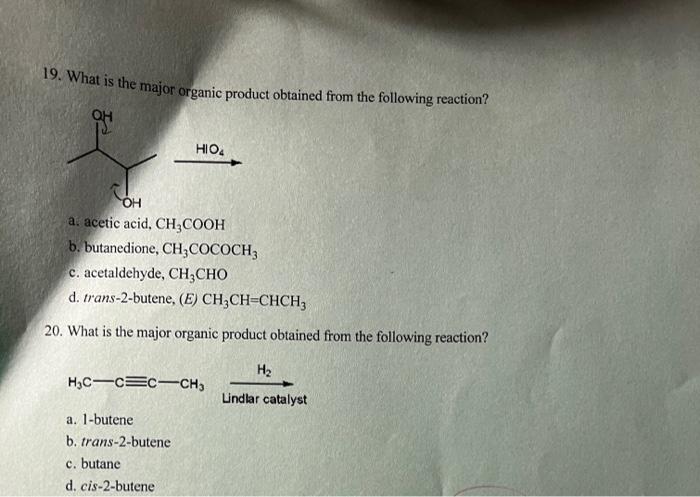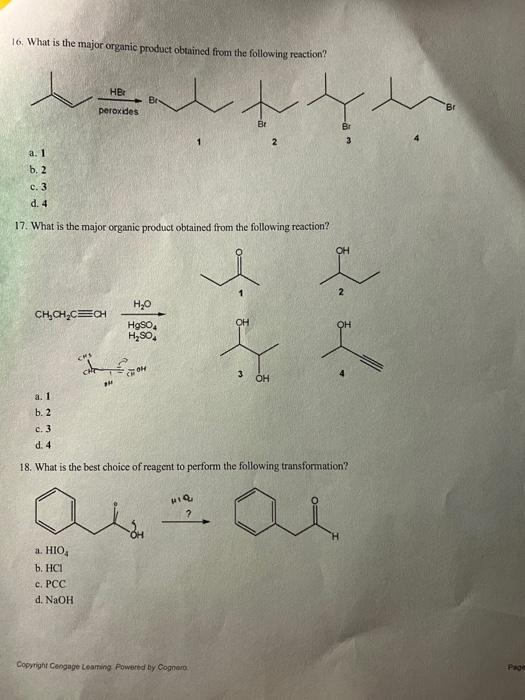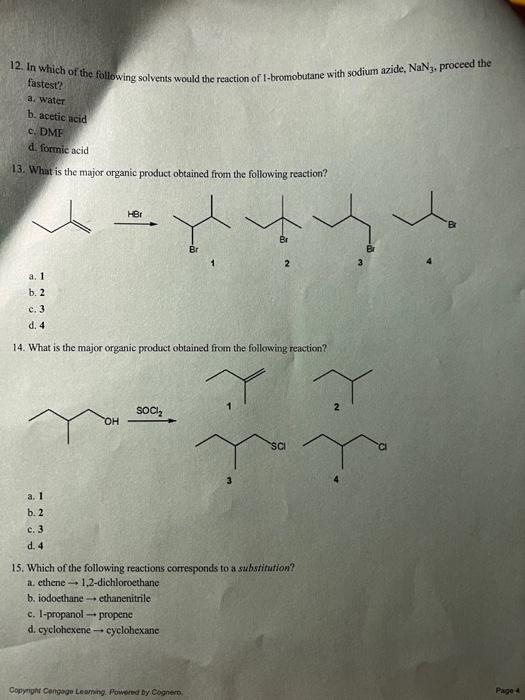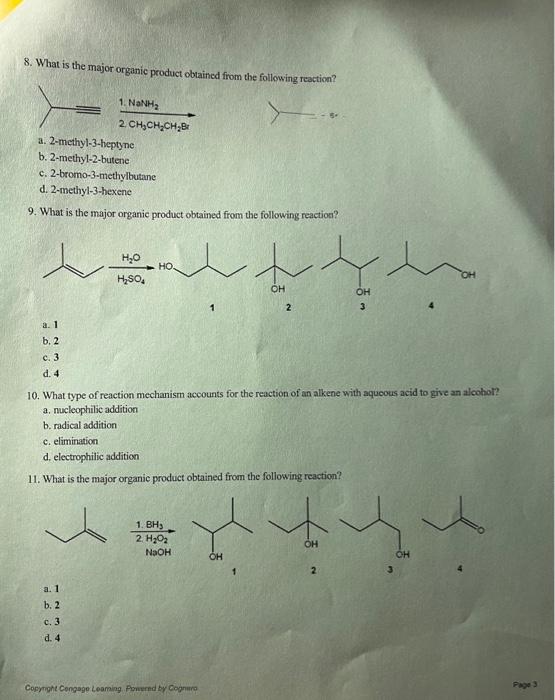please show the steps and mechanismthe for correct answer

16. What is the major organic product obtained from the following reaction? a. 1 b. 2 c. 3 d, 4 17. What is the major organic product obtained from the following reaction? a. 1 b. 2 c. 3 d. 4 18. What is the best choice of reagent to perform the following transformation? a. HIO4 b. HCl c. PCC d. NaOH 8. What is the major organic product obtained from the following reaction? a. 2-methyl-3-heptyne b. 2-methyl-2-butene c. 2-bromo-3-methylbutane d. 2-methyl-3-hexene 9. What is the major organic product obtained from the following reaction? a. 1 b. 2 c. 3 d. 4 10. What type of reaction mechanism accounts for the reaction of an alkene with aquevus acid to give an alcohol? a. nucleophilic addition b. radical addition c. elimination d. electrophilic addition 11. What is the major organic product obtained from the following reaction? a. 1 b. 2 c. 3 d. 4 5. What is the major organic product obtained from the following reaction? a. 1 b. 2 c. 3 d. 4 6. What is the major organic product obtained from the following reaction? CH3C=cCH32molBr2 a. 2,2,3,3-tetrabromobutane b. 2,3-dibromobutene c. 2,2-dibromobutane d. 2,3-dibromobutane 7. What is the major organic product obtained from the following reaction? a. butanoic acid, CH3CH2CH2COOH b. butanal, CH3CH2CH2CHO c. 1-butene, CH3CH2CH=CH2 d. butanone, CH3CH2COCH3 19. What is the major organic product obtained from the following reaction? a. acetic acid, CH3COOH b. butanedione, CH3COCOCH3 c. acetaldehyde, CH3CHO d. trans-2-butene, (E) CH3CH=CHCH3 20. What is the major organic product obtained from the following reaction? a. 1-butene b. trans-2-butene c. butane d. cis-2-butene 16. What is the major organic product obtained from the following reaction? a. 1 b. 2 c. 3 d. 4 17. What is the major organic product obtained from the following reaction? a. 1 b. 2 c. 3 d. 4 18. What is the best choice of reagent to perform the following transformation? a. HIO4 b. HCl c. PCC d. NaOH Coppripht Cengage Learning Powered by Cognaio. 12. In which of the following solvents would the reaction of I-bromobutane with sodium azide, NaN3, proceed the fastest? a. water b. acetic acid c. DME d. formic acid 13. What is the major organic product obtained from the following reaction? a. 1 b. 2 c. 3 d. 4 14. What is the major organic product obtained from the following reaction? a. 1 b. 2 c. 3 d. 4 15. Which of the following reactions corresponds to a substitution? a. ethene 1,2-dichloroethane b. iodoethane ethanenitrile c. 1-propanol propene d. cyclohexene cyclohexane Copyright Congspe Learning. Povvired by Cognerb. 8. What is the major organic product oblained from the following reaction? a. 2-methyl-3-heptyne b. 2-methyl-2-butene c. 2-bromo-3-methylbutane d. 2-methyl-3-hexene 9. What is the major organic product obtained from the following reaction? a. 1 b. 2 c. 3 d. 4 10. What type of reaction mechanism accounts for the reaction of an alkene with aquoous acid to give an alcohor? a. nucleophilic addition b. radical addition c. elimination d. electrophilic addition 11. What is the major organic product obtained from the following reaction? a. 1 b. 2 c. 3 d. 4 Copynght Congage Leaming Ponered by Cognwe 5. What is the major organic product obtained from the following reaction? b. 2 c. 3 d. 4 6. What is the major organic product obtained from the following reaction? a. 2,2,3,3-tetrabromobutane b. 2,3-dibromobutene c. 2,2-dibromobutane d. 2,3-dibromobutane 7. What is the major organic product obtained from the following reaction? a. butanoic acid, CH3CH2CH2COOH b. butanal, CH3CH2CH2CHO c. 1-butene, CH3CH2CH=CH2 d. butanone, CH3CH2COCH3 Capjright Cenguge Learring. Pouved by Cagneto


